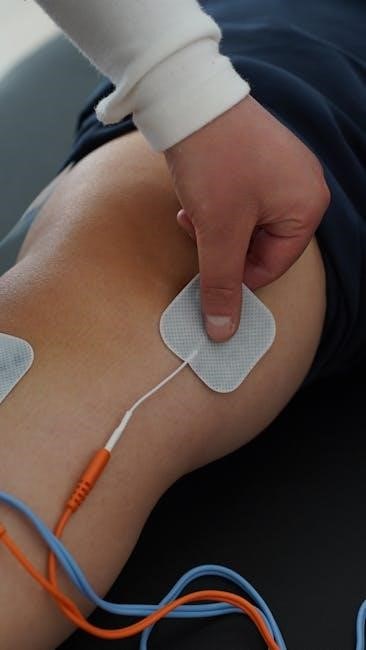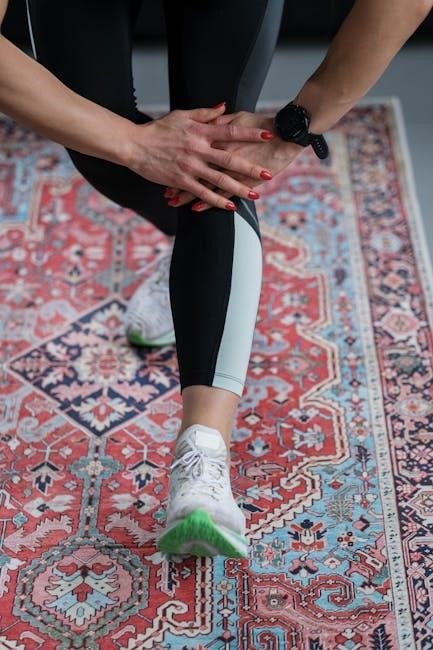
Exercises before knee replacement surgery are crucial for a smoother recovery and stronger muscles. They prepare your body and mind‚ improving mobility and reducing post-surgery challenges. Regular pre-surgery workouts enhance overall fitness and mental readiness‚ ensuring better surgical outcomes.
Overview of Knee Replacement Surgery
Knee replacement surgery‚ or knee arthroplasty‚ is a procedure to replace a damaged knee joint with artificial components. It is most commonly performed to treat severe arthritis‚ injuries‚ or degenerative conditions that cause chronic pain and limit mobility. The surgery involves removing the damaged cartilage and bone‚ then resurfacing the knee joint with metal‚ plastic‚ or ceramic prosthetics. Total knee replacement replaces the entire joint‚ while partial replacement addresses only the damaged portion. The goal is to restore function‚ reduce pain‚ and improve quality of life. Recovery typically involves physical therapy to regain strength and mobility. Recent research suggests that aggressive rehabilitation can lead to faster functional recovery without compromising range of motion. Knee replacement is a major surgery‚ but it offers significant benefits for those with severe joint damage‚ helping them return to daily activities and improve overall well-being.
Importance of Pre-Surgery Exercises
Pre-surgery exercises play a vital role in preparing the body and mind for knee replacement surgery. Strengthening the muscles around the knee improves joint stability and reduces recovery time. These exercises also enhance flexibility and mobility‚ making it easier to regain movement post-surgery. Additionally‚ pre-surgery workouts help patients mentally prepare for the recovery process‚ familiarizing them with the exercises they will perform after surgery. Studies show that patients who engage in pre-surgery exercises often experience smoother and faster recovery. Strengthening the thigh and leg muscles can also reduce the risk of complications and improve overall surgical outcomes. By committing to a pre-surgery exercise routine‚ patients can take an active role in their recovery‚ ensuring better results and a quicker return to daily activities. These exercises are a cornerstone of preparation‚ setting the stage for a successful surgery and rehabilitation journey.

Types of Exercises Recommended Before Knee Surgery
Recommended exercises include strengthening‚ flexibility‚ and cardiovascular workouts. Strengthening focuses on muscles around the knee‚ improving stability. Flexibility exercises enhance range of motion‚ while cardiovascular activities boost overall fitness and endurance.
Strengthening Exercises for the Knee
Strengthening exercises are essential to prepare the knee for surgery and aid in recovery. These exercises target the muscles around the knee‚ such as the quadriceps and hamstrings‚ improving stability and reducing strain. Straight leg raises‚ mini squats‚ and wall slides are common recommendations. They help build muscle strength without putting excessive strain on the joint. Performing these exercises regularly can enhance muscle endurance and support the knee during the healing process. It’s important to follow a structured routine‚ starting with low resistance and gradually increasing intensity. Proper form and technique are crucial to avoid injury. Strengthening the surrounding muscles also improves mobility and reduces the risk of post-surgery complications. Consistency in these exercises ensures better outcomes and faster recovery after knee replacement surgery.

Flexibility and Mobility Exercises

Flexibility and mobility exercises are vital to maintain or improve range of motion in the knee before surgery. These exercises help reduce stiffness and prepare the joint for the surgical process. Simple stretches‚ such as seated leg stretches or wall-assisted knee bends‚ can significantly enhance flexibility. Gentle movements like heel slides‚ where the heel is slowly slid toward the buttocks‚ are also effective. These exercises should be performed gently‚ within a pain-free range‚ to avoid overexertion; Improving mobility pre-surgery can make post-operative rehabilitation easier and reduce the risk of complications. Consistent practice of these exercises ensures better movement and functionality after knee replacement. Patients are often encouraged to incorporate these exercises into their daily routine‚ as they play a key role in achieving optimal surgical outcomes and a smoother recovery process.

Cardiovascular Exercises to Improve Overall Fitness
Cardiovascular exercises are essential for improving overall fitness before knee replacement surgery. These exercises enhance heart health‚ boost endurance‚ and prepare the body for the demands of surgery and recovery. Low-impact activities such as swimming‚ cycling‚ or brisk walking are ideal‚ as they minimize stress on the knee while promoting circulation and stamina. Strengthening the cardiovascular system helps the body recover faster post-surgery and reduces the risk of complications. Even gentle exercises like chair aerobics or short walks can make a significant difference. Consistency is key‚ as regular cardiovascular workouts improve mental well-being and energy levels. Patients are encouraged to incorporate these exercises into their pre-surgery routine to enhance surgical outcomes and overall recovery. A stronger cardiovascular system ensures better preparation for the physical challenges ahead‚ making the journey to recovery smoother and more manageable.

Preparing Your Body and Mind for Surgery
Preparing your body and mind for surgery involves mental readiness‚ physical health optimization‚ and lifestyle adjustments. These steps‚ combined with exercises‚ enhance recovery and overall surgical success effectively.
Mental Preparation and Setting Realistic Expectations
Mental preparation is vital for a successful knee replacement journey. Setting realistic expectations helps manage recovery challenges. Understanding the process and outcomes reduces anxiety‚ fostering resilience. Familiarizing oneself with post-surgery routines and physical therapy builds confidence. A positive mindset accelerates healing and adaptation to lifestyle changes. Patients should discuss concerns with healthcare providers to align goals with realistic outcomes‚ ensuring a smoother transition into rehabilitation. This mental readiness‚ combined with pre-surgery exercises‚ enhances overall recovery and long-term satisfaction.
Nutrition and Lifestyle Adjustments
Nutrition and lifestyle adjustments play a significant role in preparing for knee replacement surgery. A balanced diet rich in proteins‚ vitamins‚ and minerals supports muscle strength and tissue repair. Incorporating foods high in omega-3 fatty acids‚ such as fish‚ can reduce inflammation. Staying hydrated is essential for overall health and surgical recovery. Additionally‚ maintaining a healthy weight through proper nutrition can alleviate stress on the knee joint. Smoking and excessive alcohol consumption should be avoided‚ as they hinder healing and increase surgical risks. A structured sleep routine is also crucial for physical and mental recovery. By making these adjustments‚ patients can optimize their body’s readiness for surgery and enhance their post-operative outcomes. A well-planned lifestyle strategy ensures a smoother transition into the recovery phase and long-term joint health.

What to Expect After Knee Replacement Surgery
After knee replacement surgery‚ expect a structured recovery process involving physical therapy‚ pain management‚ and gradual mobility restoration. Proper care and adherence to medical advice are crucial for optimal outcomes and faster healing.
Recovery Timeline and Rehabilitation Process
The recovery timeline after knee replacement surgery typically spans several months‚ with significant progress expected within the first few weeks. Immediately following surgery‚ patients often experience swelling‚ pain‚ and limited mobility. Physical therapy begins shortly after‚ focusing on restoring knee movement and strengthening surrounding muscles. Most patients can walk with assistance within days and transition to independent walking within weeks. Full recovery usually takes 3 to 6 months‚ with continued improvement in strength and mobility. A structured rehabilitation plan‚ including exercises and pain management‚ is essential for optimal outcomes. Adhering to medical advice and maintaining a consistent therapy routine ensures faster healing and better long-term results. Proper care during this period is critical to avoid complications and achieve full functional recovery.
Role of Physical Therapy in Post-Surgery Recovery
Physical therapy plays a vital role in post-surgery recovery after knee replacement‚ helping patients regain strength‚ mobility‚ and functionality. A tailored therapy plan addresses individual needs‚ focusing on exercises to improve range of motion‚ balance‚ and muscle strength. Therapists guide patients through gentle movements initially‚ progressing to more intense workouts as healing advances. Pain management techniques and swelling reduction are also integral parts of therapy. Regular sessions ensure proper alignment and prevent complications‚ while fostering independence in daily activities. The therapist’s expertise helps patients avoid overexertion and adapt exercises as needed. Consistent participation in physical therapy significantly enhances recovery outcomes‚ enabling patients to return to normal life and activities more effectively. The collaborative effort between patient and therapist is key to achieving long-term success and optimal knee function.
Safety Considerations for Pre-Surgery Exercises
Avoid overexertion and prevent injuries by modifying exercises based on individual needs. Consult healthcare providers to tailor routines‚ ensuring safety and effectiveness. Listen to your body to avoid strain.

Modifying Exercises Based on Individual Needs
Modifying exercises before knee replacement surgery ensures safety and effectiveness for each patient. Factors like pain levels‚ mobility‚ and overall health guide these adjustments. For instance‚ individuals with severe knee pain may benefit from low-impact activities such as swimming or cycling instead of high-impact exercises. Additionally‚ patients with limited mobility can perform seated or wall-assisted exercises to avoid strain. It’s crucial to consult with a healthcare provider or physical therapist to tailor a workout plan that suits personal capabilities. This personalized approach helps prevent overexertion and injuries while maximizing the benefits of pre-surgery preparation. By adapting exercises to individual needs‚ patients can achieve stronger muscles and better joint mobility‚ which are essential for a successful surgery and recovery.
Avoiding Overexertion and Preventing Injuries
Avoiding overexertion is critical when performing exercises before knee replacement surgery. Overexertion can lead to injuries‚ delaying surgery or complicating recovery. It’s essential to listen to your body and stop if pain exceeds a manageable level. High-impact activities‚ such as running or jumping‚ should be avoided to prevent further knee damage. Instead‚ focus on low-impact exercises like swimming‚ cycling‚ or gentle stretching. Proper form and technique are vital to avoid strain on the knee joint. Using assistive devices‚ such as a cane or walker‚ can reduce pressure on the knee during mobility exercises. Additionally‚ consulting with a physical therapist ensures exercises are tailored to your specific condition‚ minimizing injury risks. Prioritizing safety and moderation in your pre-surgery routine helps protect your knee and supports a successful surgical outcome.
Additional Resources and Guides
Downloadable PDF guides and online resources provide detailed exercise routines and tracking tools. These materials help patients prepare effectively for surgery and monitor their progress‚ ensuring a well-structured pre-surgery plan.
Downloadable PDF Guides for Pre-Surgery Exercises
Downloadable PDF guides offer comprehensive exercise plans tailored for patients preparing for knee replacement surgery. These guides typically include detailed instructions‚ images‚ and videos to ensure proper form and technique. They cover strengthening exercises for the quadriceps‚ hamstrings‚ and calves‚ as well as flexibility routines to improve joint mobility. Many guides also incorporate cardiovascular exercises to enhance overall fitness. By following these structured programs‚ patients can build muscle strength‚ improve balance‚ and reduce the risk of complications post-surgery. Additionally‚ these resources often provide tips on mental preparation‚ nutrition‚ and lifestyle adjustments to optimize recovery. PDF guides are convenient and accessible‚ allowing patients to track their progress and stay motivated throughout their pre-surgery journey. They serve as invaluable tools for patients aiming to achieve the best possible outcomes after knee replacement surgery.
Tracking Progress and Staying Motivated
Tracking progress and staying motivated are essential for maximizing the benefits of pre-surgery exercises. Many patients use downloadable PDF guides to monitor their daily routines‚ set achievable goals‚ and celebrate milestones. These guides often include checklists‚ progress charts‚ and inspirational tips to keep patients engaged. Setting realistic expectations and rewarding small accomplishments can boost morale and encourage consistency. Sharing progress with a healthcare provider or support group can also provide accountability and encouragement. Additionally‚ focusing on how these exercises improve mobility and strength helps patients stay motivated‚ knowing they are investing in a smoother recovery. By maintaining a positive mindset and tracking improvements‚ individuals can stay committed to their exercise regimen and feel more prepared for surgery and the rehabilitation process ahead.
Exercises before knee replacement surgery are vital for a successful outcome. Consistency and adherence to routines enhance strength‚ mobility‚ and mental readiness‚ ensuring a smoother recovery and improved long-term results.

Final Tips for a Successful Surgery and Recovery
Adhering to a structured exercise plan before knee replacement surgery is essential for optimal results. Strengthening muscles‚ improving flexibility‚ and maintaining cardiovascular health can significantly enhance recovery. Mental preparation is equally important‚ as setting realistic expectations helps manage post-surgery challenges. Proper nutrition and lifestyle adjustments‚ such as avoiding smoking and managing weight‚ also play a crucial role in healing. After surgery‚ following the rehabilitation plan and attending physical therapy sessions will ensure a faster return to normal activities. Tracking progress and staying motivated through goal-setting can make the recovery process more manageable. By combining these strategies‚ patients can achieve a smoother and more successful surgical outcome‚ leading to improved mobility and a better quality of life.
